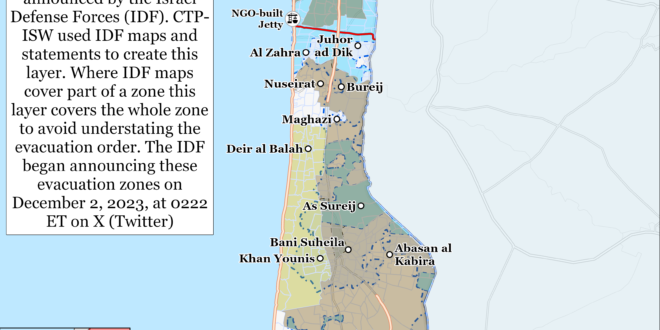The US Embassy in Baghdad assessed that Iranian-backed Iraqi militias likely conducted the attack a US diplomatic compound near Baghdad International Airport on September 10.[1] CTP-ISW also assessed on September 11 that Iranian-backed Iraqi militias conducted the September 10 attack. The US Embassy in Baghdad said on September 11 that an attack targeted the Baghdad Diplomatic Services Compound, a US diplomatic facility.[2] An unspecified military official told AFP on September 11 that militants fired two Katyusha-type rockets in the attack. One rocket struck the wall of an Iraqi Counter Terrorism Service building and the other rocked landed inside an international coalition base, presumably a reference to the Baghdad Diplomatic Services Compound.[3] CTP–ISW previously noted that Iranian-backed Iraqi militants seem to have conducted the attack against the wishes of Iranian-backed Iraqi militia Kataib Hezbollah and the Islamic Resistance in Iraq, which is a coalition of Iranian-backed Iraqi militias.[4] The US Embassy called on the Iraqi government to protect US and coalition personnel and facilities.[5] The US government has often emphasized to the Iraqi government, especially Prime Minister Mohammed Shia al Sudani, the importance of ensuring the safety of US forces following Iranian-backed Iraqi militia attacks on US bases in Iraq and Syria.[6]
Hamas leader Yahya Sinwar sent a letter to Lebanese Hezbollah Secretary General Hassan Nasrallah vowing to continue Hamas’ fight against Israel, according to Hezbollah-affiliated media.[7] Sinwar reportedly wrote the letter at an unspecified date after former Hamas political leader Ismail Haniyeh’s death on July 31.[8] Hezbollah-affiliated Al Mayadeen reported that Sinwar wrote that Hamas will “remain steadfast” until Israel is defeated and an independent Palestinian state with Jerusalem as the capital is established.[9] Sinwar also thanked Nasrallah for Iranian-backed groups’ efforts to support Hamas since the beginning of the Israel-Hamas war.[10] Hezbollah began its cross-border attacks in northern Israel in October 2023 in support of Hamas in the Gaza Strip. Hezbollah also harbors Hamas elements in Lebanon and permits them to conduct attacks into Israel.[11] The al Qassem Brigades recently an attack targeting an IDF site in northern Israel with rockets fired from Lebanon, for example.[12]
The al Qassem Brigades—Hamas’ military wing—claimed on September 11 that its fighters continue to engage Israeli forces across the Gaza Strip.[13] Hamas has not claimed many individual attacks targeting Israeli forces in the Gaza Strip in recent weeks, however. Israeli Defense Minister Yoav Gallant said on September 9 that Hamas is no longer an organized military force in the Gaza Strip, suggesting that IDF operations have disrupted Hamas’ ability to operate as a conventional military.[14]
The IDF said on September 13 that it discovered a small tunnel during a multi-day operation in Tulkarm.[15] The IDF said that the tunnel was near a hospital in the Tulkarm refugee camp.[16] The IDF added that the tunnel had only one entrance, which could indicate the tunnel was still under construction, according to an Israeli journalist.[17] Multiple entrances and exits to a tunnel network improve its resilience. Israeli media reported in March 2024 that the IDF has established a team to locate tunnels in the West Bank.[18] The IDF reportedly established the unit after residents near Tulkarm heard digging noises near their homes. An unspecified security official said that the unit is aware that “terrorist organizations [in the West Bank] are trying to mimic some of the combat methods in Gaza” and that these organizations use underground facilities for weapons storage. The IDF previously discovered one tunnel dozens of meters long in Jenin refugee camp in July 2023.
The Pentagon announced on September 12 that the USS Theodore Roosevelt carrier strike group is leaving the CENTCOM area of responsibility and is en route to the Indo-Pacific area of command.[19] The USS Roosevelt arrived in the CENTCOM area of responsibility on July 12 to deter or defend against an Iranian retaliatory strike targeting Israel.[20] The USS Abraham Lincoln carrier strike group will remain in the CENTCOM area of responsibility.
Iranian President Masoud Pezeshkian concluded his official three-day trip to Iraq on September 13.[21] Pezeshkian met with Patriotic Union of Kurdistan (PUK) leaders in Sulaymania, Iraqi Kurdistan, on September 12.[22] Pezeshkian emphasized Iraqi Kurdistan’s importance to Iran during the meeting. Pezeshkian said that he hoped to increase economic relations between Iran and Iraqi Kurdistan. PUK President Bafel Talabani stated that Iraqi Kurdistan will ”fully and accurately implement what is mentioned in the security agreement.” This is likely in reference to the March 2023 security agreement between Baghdad and Tehran. This agreement requires Iraqi authorities to disarm and relocate members of Kurdish opposition groups away from the Iran-Iraq border.[23] Talabani reiterated his commitment to securing the border between Iran and Iraqi Kurdistan.[24] This marked the first time an Iranian President travelled to Iraqi Kurdistan.[25]
Pezeshkian also visited religious sites in Karbala and Najaf on September 12.[26] Pezeshkian emphasized the need for unity amongst Muslims in a meeting with Iraqi elites, academics, and nomads in Basra on September 13.[27] Pezeshkian reiterated his support for concepts that would enable the free movement of people between Muslim countries in a fashion similar to the European Union.[28] Iranian Foreign Affairs Minister Abbas Araghchi accompanied Pezeshkian on the trip.[29] Pezeshkian returned to Tehran from Basra on September 13.[30]
Iranian-backed Iraqi militia Kataib Sayyid al Shuhada Secretary General Abu Alaa al Walai claimed Iranian-backed Iraqi militias will soon begin their fourth phase of operations against Israel.[31] Walai explained in an interview to Iranian state-owned media this phase will include joint military operations and coordinated actions between Iranian-backed Iraqi groups and another Axis of Resistance members across multiple fronts. Walai outlined the previous three operational phases. Walai said that in the first phase, Iraqi groups attacked US bases before attacking Israel in the second phase. In the third phase, Iranian-backed Iraqi groups conducted joint operations with the Houthis.[32] The Islamic Resistance in Iraq, a coalition of Iranian-backed Iraqi militias that includes Kataib Sayyid al Shuhada, conducted over 170 attacks targeting US forces in Iraq and Syria between October 2023-January 2024.[33] Other Iranian-backed Iraqi militias have conducted occasional attacks on US forces in Iraq and Syria since January 2024, but the Islamic Resistance in Iraq targeted Israel in most of its attacks after January 2024.[34] CTP-ISW has also reported extensively on how the military relationship between the Houthis and Iranian-backed Iraqi militias has deepened in recent months.[35] The Houthis and the Islamic Resistance in Iraq first claimed to conduct a joint drone attack targeting Israel on June 6. The last joint attack occurred on June 15.[36] A US self-defense strike on July 30 targeting a prominent Iranian-backed Iraqi militia facility killed a Houthi drone expert who had traveled to Iraq to train other Iranian-backed Iraqi militias in drone tactics, indicating the deepening relationship between Iraqi groups and the Houthis.[37]
Key Takeaways:
- Iraq: The US Embassy in Baghdad assessed that Iranian-backed Iraqi militias likely conducted the attack a US diplomatic compound near Baghdad International Airport on September 10. CTP-ISW also assessed on September 11 that Iranian-backed Iraqi militias conducted the September 10 attack.
- Gaza Strip: The al Qassem Brigades—Hamas’ military wing—claimed on September 11 that its fighters continue to engage Israeli forces across the Gaza Strip. Hamas has not claimed many individual attacks targeting Israeli forces in the Gaza Strip in recent weeks, however.
- West Bank: The IDF said on September 13 that it discovered a small tunnel during a multi-day operation in Tulkarm. The IDF said that the tunnel was near a hospital in the Tulkarm refugee camp. The IDF added that the tunnel had only one entrance, which could indicate the tunnel was still under construction, according to an Israeli journalist. Multiple entrances and exits to a tunnel network improve its resilience.
- Iranian Retaliation: The Pentagon announced on September 12 that the USS Theodore Roosevelt carrier strike group is leaving the CENTCOM area of responsibility and is en route to the Indo-Pacific area of command.
- Iran: Iranian President Masoud Pezeshkian concluded his official three-day trip to Iraq on September 13.
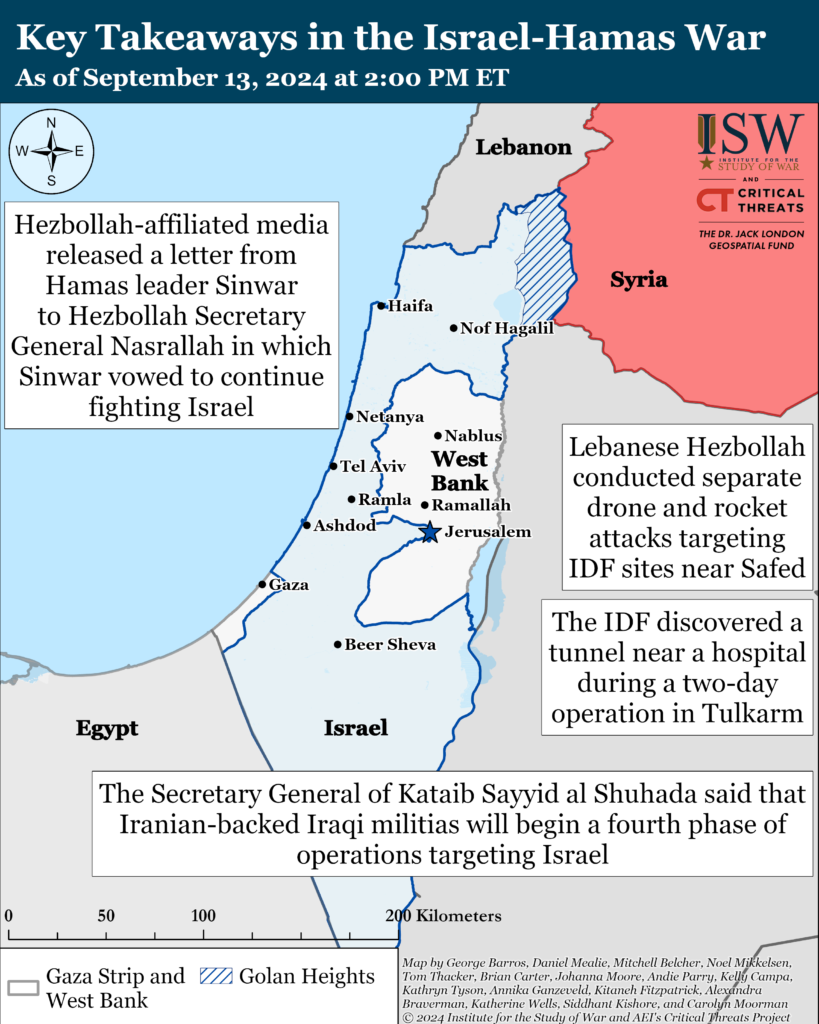
Gaza Strip
Axis of Resistance objectives:
Erode the will of the Israeli political establishment and public to sustain clearing operations in the Gaza Strip
Reestablish Hamas as the governing authority in the Gaza Strip
Palestinian Islamic Jihad (PIJ) fired rockets targeting Israeli forces along the Netzarim Corridor on September 13.[38]
The IDF appeared to continue clearing operations in Rafah on September 12. Commercially available satellite imagery captured on September 12 shows flattened terrain and destroyed buildings northeast of Taha Hussein Street in Rafah, indicating that Israeli tanks or bulldozers operated in Rafah. The IDF last acknowledged its ground operations in Rafah on September 10.[39]
Israeli officials emphasized that Hamas’ underground smuggling network existed along the Philadelphi Corridor but that Hamas only brought in a “very small” percentage of its weapons through those routes.[40] The former director of Shin Bet, Nadav Argaman, told Israeli media that only a “very small number of weapons” had been smuggled into Gaza through the tunnels since Egypt had made concerted efforts to clear the border of tunnels between 2013 and 2016.[41] The IDF discovered a tunnel beneath the Philadelphi Corridor wide enough for large vehicles to pass through on August 4.[42] The IDF did not specify at the time whether the tunnel was in use or if it led into Egyptian territory.[43] Images of the tunnel entrance, though, show that the tunnel probably travels south towards the Egypt-Gaza Strip border, which is only a few hundred meters south of the tunnel entrance.[44] Israeli military correspondents who visited the Philadelphi Corridor on September 12 reported that the large tunnel in question did cross into Egypt but was not active at the time it was found.[45] Hamas reportedly collapsed a portion of the tunnel on the Rafah side, and the IDF reported that the tunnel was also collapsed from the Egyptian side.[46] Unspecified IDF sources and Israeli defense officials said on September 12 and 13 that Hamas did not primarily use underground tunnels for smuggling weapons into the Gaza Strip from Egypt and relied heavily on the Rafah Crossing and other aboveground routes.[47]
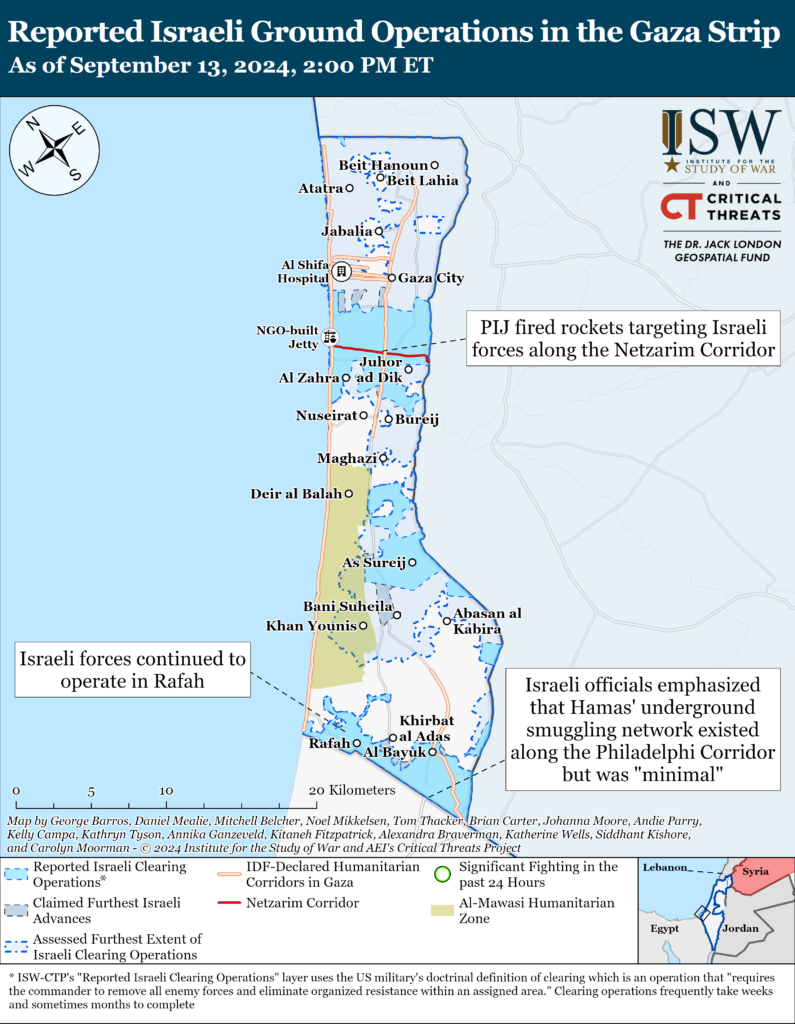
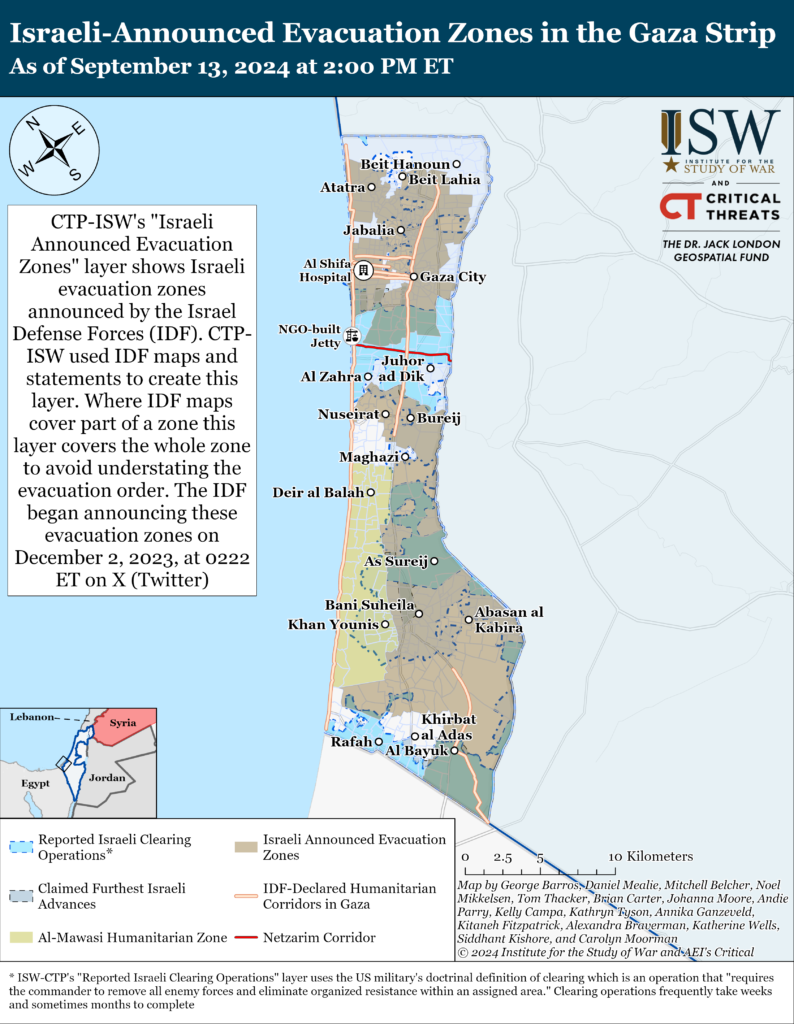
Humanitarian aid groups completed the first phase of a mass polio vaccination campaign in the Gaza Strip on September 12.[48] The World Health Organization said that over 560,000 Gazan children under the age of 10 have received the first of two polio vaccines since the campaign began on September 1.[49] The United Nations Relief and Works Agency (UNRWA) said that it and its partners vaccinated 90% of targeted children.[50] Israel and Hamas both agreed to observe limited humanitarian pauses in designated areas of the central, southern, and northern Gaza Strip throughout the campaign. The IDF conducted limited military operations elsewhere in the Gaza Strip during the humanitarian pauses.[51] The IDF has not stated if it will return to its former rate of operations following the conclusion of the polio vaccination campaign.
West Bank
Axis of Resistance objectives:
Establish the West Bank as a viable front against Israel
Israeli forces engaged Palestinian fighters in three locations in Tubas, south of Jenin, since CTP-ISW’s last data cutoff on September 12.[52] Palestinian Islamic Jihad (PIJ) mourned the deaths of five fighters killed in Tubas on September 13. PIJ said that the fighters were members of PIJ’s manufacturing and engineering unit.
The IDF destroyed a possible vehicle-borne improvised explosive device (VBIED) during recent operations in Tubas.[54] The IDF has conducted operations in several areas across the West Bank, including Tubas, in recent days as part of a major operations to degrade Palestinian militia networks in the West Bank.[55] The IDF said on September 13 that it located an explosive-laden vehicle with a remote detonator in the Faraa refugee camp in Tubas during its recent operations.[56] An Israeli Army Radio correspondent reported that an IDF airstrike destroyed the vehicle, citing Palestinian sources.[57] The correspondent added that unspecified security sources said that the explosion was a “work accident.” A picture of the vehicle shows that the vehicle is intact but moderately damaged, suggesting that the vehicle only contained a small amount of explosives or was not a VBIED. The level of damage that the vehicle sustained is inconsistent with a VBIED detonation, which usually leaves only burned-out remnants of a vehicle or no recognizable vehicle at all.
The IDF said on September 12 that it killed three senior PIJ fighters in a drone strike in the Nour Shams refugee camp in Tulkarm on September 11.[58] The IDF said that the fighters planned and conducted small arms and improvised explosive device attacks against Israeli forces.[59] One of the fighters also killed an Israeli border police officer in October 2023.[60]
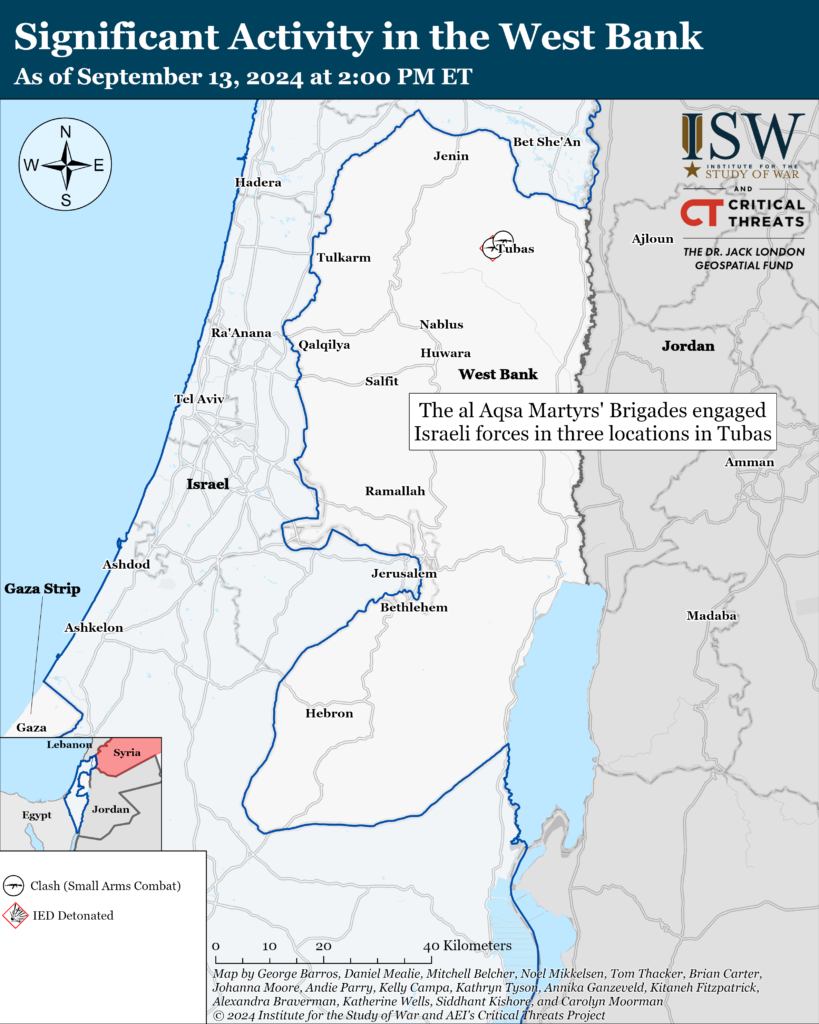
This map is not an exhaustive depiction of clashes and demonstrations in the West Bank.
Southern Lebanon and Golan Heights
Axis of Resistance objectives:
Deter Israel from conducting a ground operation into Lebanon
Prepare for an expanded and protracted conflict with Israel in the near term
Expel the United States from Syria
Iranian-backed militias, including Lebanese Hezbollah, have conducted at least 11 attacks into northern Israel since CTP-ISW’s last data cutoff on September 12.[61] Lebanese Hezbollah launched approximately 20 rockets targeting the IDF’s Northern Command air defense base in Safed.[62] The IDF intercepted most of the rockets and the remainder fell in open areas.[63] Lebanese Hezbollah separately conducted a drone attack targeting the headquarters of the IDF 210th Division in Safed.[64] The IDF reported that the drone fell in Upper Galilee and caused no casualties.[65]
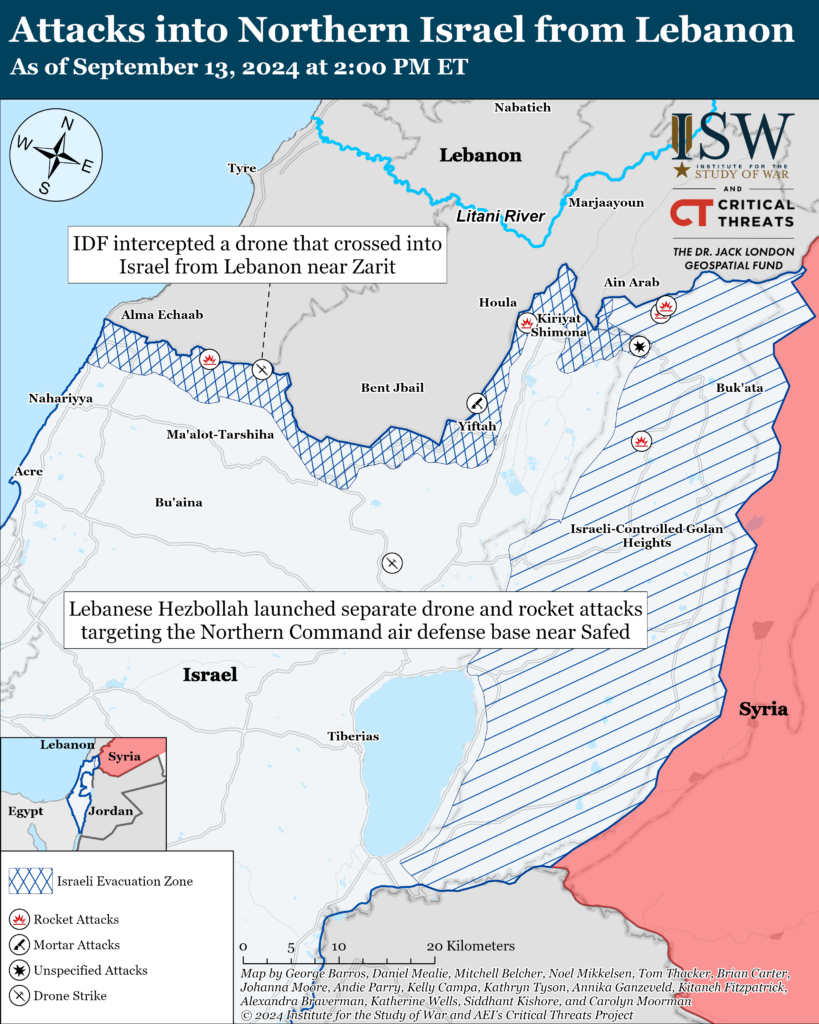
Iran and Axis of Resistance
Jaish al Adl fighters killed three Iranian border guards in Mirjaveh city, Sistan and Baluchistan Province, on September 12.[66] The Jaish al Adl militants injured one civilian during the attack. Iranian First Vice President Mohammad Reza Aref emphasized the need for a comprehensive investigation into the attack and to strengthen the country’s borders in separate phone calls with Interior Minister Eskander Momeni and Sistan and Baluchistan Governor Mohammad Karami.[67] Jaish al Adl—a Baloch Salafi-jihadi group—has conducted numerous attacks targeting Iranian security services and personnel in Sistan and Baluchistan Province, Iran, since December 2023.[68]
Iranian Parliamentary National Security and Foreign Policy Commission member Ali Khezarian said that Iran needed to address border disputes with Azerbaijan in an interview with Iranian media.[69] Khezarian recently visited Azerbaijan as part of a Shanghai Cooperation Organization (SCO) parliamentary delegation monitoring Azerbaijan’s National Assembly elections on September 1.[70] Khezarian stated that the Astara border crossing between the two states on the Caspian coast, which is part of the International North-South Transit Corridor (INSTC), is not operational because of poor road maintenance.[71] Khezarian claimed that accelerating the north-western Aras crossing project construction would circumvent trade issues for Iran if Turkey and Azerbaijan construct the Zangezur Corridor.
Iranian Supreme National Security Council Secretary Ali Akbar Ahmadian met with Belarusian President Alexander Lukashenko and Belarusian State Security Council Secretary Alexander Volfovich in Minsk, Belarus, on September 13.[72] Lukashenko emphasized the importance of strong economic and commercial relations between Iran and Belarus. Lukashenko invited Iranian President Masoud Pezeshkian to visit Minsk.[73] Ahmadian and Volfovich discussed deepening bilateral relations and the need to promote strategic relations in international frameworks such as BRICS and the SCO. Ahmadian’s visit to Belarus follows his attendance at the BRICS forum in St. Petersburg, Russia.[74]
The Jordanian Army said on September 12 that it used a drone to thwart a narcotics smuggling attempt near the Jordan-Syria border.[75] Jordanian security forces have repeatedly countered attempts to smuggle drugs across the border, including launching airstrikes against Iran-linked smugglers in Syria.[76]
 Eurasia Press & News
Eurasia Press & News
